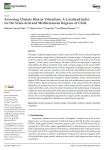Cuevas-Zárate K., Cortez D., Soto J., Paneque M. (2025). Assessing climate risk in viticulture: a localized index for the semi-arid and Mediterranean Regions of Chile. Agriculture, 02/06/2025, vol. 15, n. 12, p. 1322.
http://doi.org/10.3390/agriculture15121322
http://doi.org/10.3390/agriculture15121322
| Titre : | Assessing climate risk in viticulture: a localized index for the semi-arid and Mediterranean Regions of Chile (2025) |
| Auteurs : | K. Cuevas-Zárate ; D. Cortez ; J. Soto ; M. Paneque |
| Type de document : | Article |
| Dans : | Agriculture (vol. 15, n. 12, June 2025) |
| Article en page(s) : | p. 1322 |
| Langues : | Anglais |
| Langues du résumé : | Anglais |
| Catégories : |
Catégories principales 07 - ENVIRONNEMENT ; 7.6 - Changement ClimatiqueThésaurus IAMM CHANGEMENT CLIMATIQUE ; ADAPTATION AU CHANGEMENT ; CLIMAT MEDITERRANEEN ; VITICULTURE ; CHILI |
| Résumé : | Viticulture contributes significantly to Chile?s exports and GDP. However, the development and productivity of grapevines is threatened by climate change. Grapevines are grown in diverse regions; thus, adaptable tools for evaluating climate risk at the local level are required. In this study, a local climate risk index (LCRI) was developed to assess the vulnerability of Chilean viticulture (wine, table, and pisco grapes) in the current (2017-2024) and future (2046-2065) periods. Various components, including exposure, sensitivity, and adaptive and response capacities, were analyzed using different indicators based on municipal-level information. The results for the current period indicated that most municipalities were at medium risk, whereas future projections showed a marked increase in climate risk, principally due to changes in climate suitability. In the current period, the highest LCRI values were observed in semi-arid and mediterranean zones, particularly in the northern regions of Atacama and Coquimbo; in the future period, this situation intensified. In contrast, the lowest values in the current period occurred in the Maule region and further south, where the climate transitions from mediterranean to temperate conditions, and in the future period, valley and mountainous areas presented improvements in the index. Some municipalities showed improvement or stability with local adaptation efforts. The results highlight the urgent need for region-specific adaptation policies that prioritize water management, infrastructure, and increased capacities. |
| Cote : | En ligne |
| URL / DOI : | http://doi.org/10.3390/agriculture15121322 |







